Last Updated on April 14, 2025 by Owen McGab Enaohwo

The manufacturing industry is booming. In 2025, the global sector is projected to reach an output of $49.3 trillion, with steady growth expected through 2029. But here’s the catch: While this growth is happening in the industry, not every manufacturer is reaping these benefits. The lack of standardized processes leaves even top manufacturing companies vulnerable to inefficiencies.
A single misstep in production can lead to costly delays, compliance headaches, and quality control failures. Standard operating procedures (SOPs) are the backbone of a smooth manufacturing process. Think of them as the blueprint that keeps manufacturing lines running flawlessly, ensuring every machine, worker, and process operates with precision.
A well-crafted manufacturing SOP enables organizations to meet their production targets with minimal errors.
In this article, we’ll guide you through writing effective SOPs for manufacturing and share industry-specific templates, step-by-step guides, and tools to help you automate SOP documentation.
Table of Contents
Why Are SOPs Important in Manufacturing Processes?
How To Create a Manufacturing SOP: A Step-by-Step Guide
How To Create and Manage Your Manufacturing SOPs With SweetProcess
Manage Your Company’s Manufacturing SOPs in One Place
9 Manufacturing SOP Templates & Examples To Inspire Your Team
Real-Time SOP Examples Used by Manufacturers
Digitalization of Manufacturing SOPs: Reasons and Benefits
Create and Manage Your Manufacturing SOPs in One Place
What Is a Manufacturing SOP?
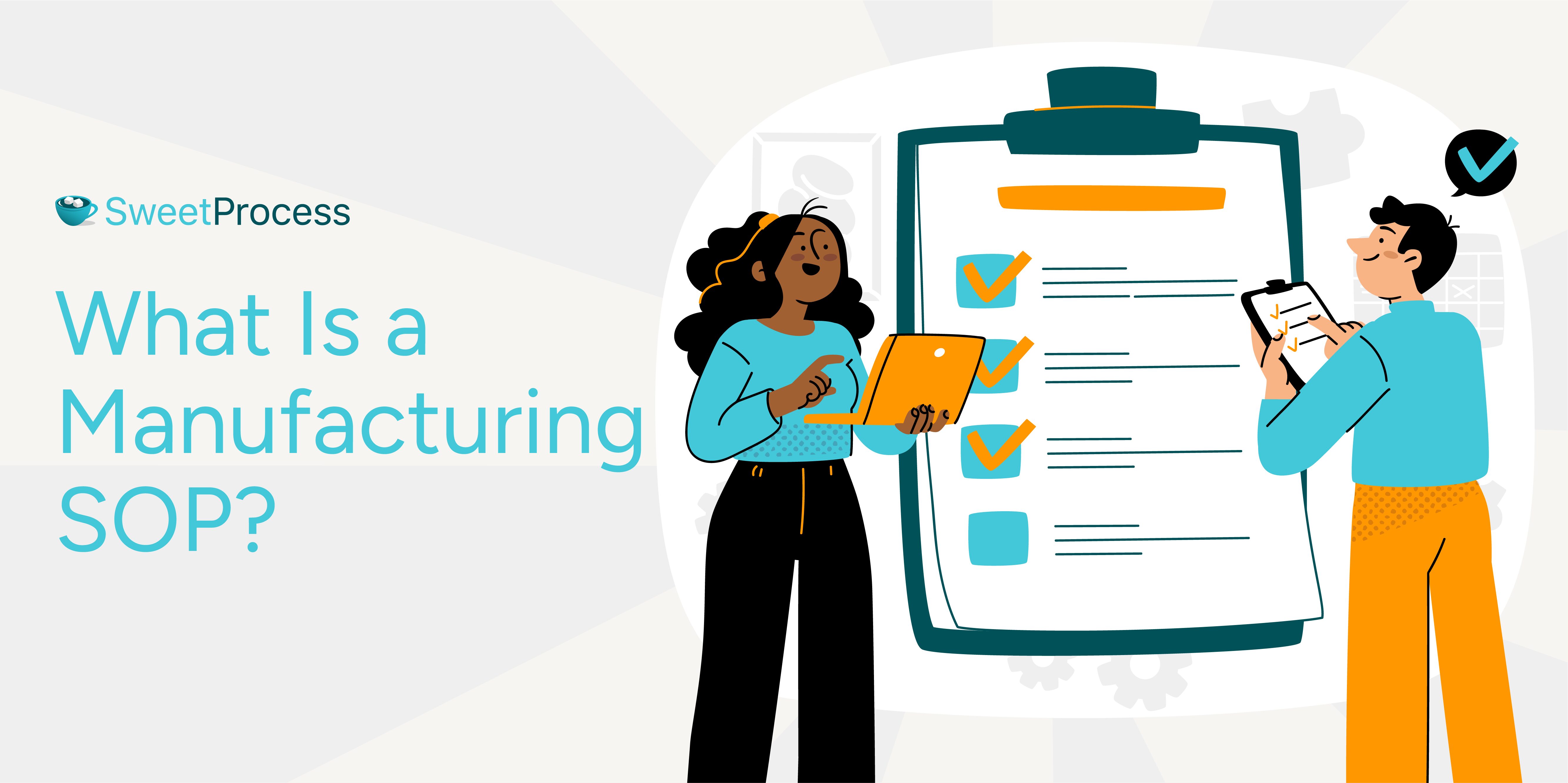
A manufacturing standard operating procedure (SOP) documents how a company should execute specific tasks to maintain efficiency. Employees follow these standards to eliminate production errors and maintain product quality.
You can use SOPs to standardize quality control, safety protocols, equipment setup, and employee training. Manufacturing companies implementing this process standardization can reduce their production downtime since team members have a reference point for every activity.
Why Are SOPs Important in Manufacturing Processes?
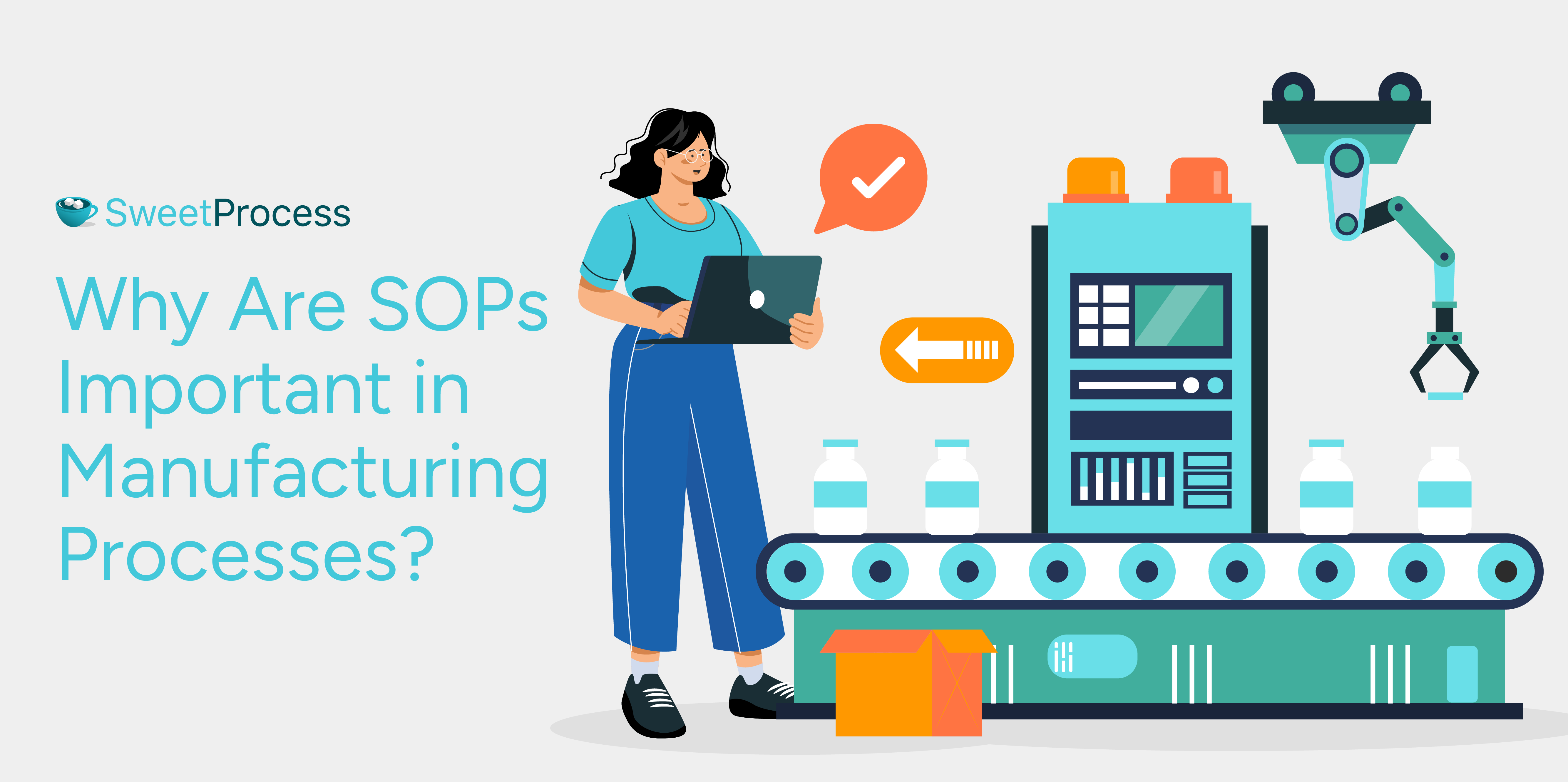
Your company’s bottom line is sensitive to deviations such as defective products and production delays. You could lose customers and waste a lot of company resources. Let’s take a look at why manufacturing SOPs should be a critical part of your business.
Aids Task Standardization
If your employees follow different production methods or skip critical processes in the assembly line, your products might be defective. This leads to unhappy customers and poor retention rates.
SOPs eliminate this inconsistency by providing clear, repeatable instructions for every manufacturing process. Your team will execute every step the same way, every time, whether operating machinery, mixing raw materials, or packaging products. They are an essential part of managing quality control in your operations.
Improves Tracking and Accountability
When production errors occur, the first question is always: “Who’s responsible?” But without structured procedures, accountability becomes a guessing game.
SOPs establish clear responsibilities for every task, ensuring that employees know what they are accountable for. Supervisors and factory managers can track who followed the SOPs correctly and where deviations occurred. This way, they can pinpoint inefficiencies and improve training to avoid future mistakes.
For instance, if your car manufacturing plant uses workstation-specific SOPs, you can trace an assembly error back to a station and correct it immediately.
Maximizes Production Efficiency

Time is money in manufacturing. Any form of delays and reworks can slow down production and drive up costs. For instance, if your factory employees mess up a product by following the wrong steps, this slows down the production process.
However, with SOPs in place, you can streamline workflows and minimize downtime since there’s an established structure. Moreover, this boosts overall efficiency by ensuring that tasks are performed in the fastest and most effective way possible. Teams spend less time figuring things out and more time getting things done.
Ensures Workplace Safety
In 2023, 5,283 fatal work-related injuries were reported. Some of them occurred in manufacturing environments with heavy machinery, hazardous materials, and high-risk tasks. A safety lapse can lead to serious injuries, lawsuits, and even financial losses.
Manufacturing SOPs are vital because they clearly define safety protocols. They outline details such as:
- The exact protective gear employees must wear
- How to handle machinery
- How to store chemicals
- Steps to follow in case of emergencies
Your company could significantly reduce accidents if you have well-documented SOPs that are accessible to employees.
Documentation of Institutional Knowledge
What happens when your most experienced technician or engineer retires? Does their knowledge walk out the door with them? Many companies lose valuable operational expertise when employees leave because processes were never properly documented.
It’s advisable to document your SOPs as part of your operations management. This way, you capture institutional knowledge, ensuring that even new hires can step in and follow time-tested processes without costly trial and error.
Guarantees Regulatory Compliance

You risk hefty fines, legal issues, and even factory shutdowns for failing to comply with industry regulations. Manufacturing companies must comply with Occupational Safety and Health Administration (OSHA), Food and Drug Administration (FDA), International Organization for Standardization (ISO), or other industry-specific regulations.
One of the best ways to ensure that your team follows these protocols is by outlining procedures and standards that align with this. These SOPs will be your saving grace when it’s time for a company audit.
How To Create a Manufacturing SOP: A Step-by-Step Guide

We’ve already identified that the manufacturing SOPs will benefit your business. But how can you create one that works well for your team? Here’s a step-by-step guide that you can follow:
Step 1: Identify the Process
Your operation has multiple processes running at the same time. Some may be working well, while others need improvement. Your first step before developing an SOP is identifying the specific processes that require standardization.
Here’s what to consider:
- Examine your business tasks and their impact on your company’s efficiency.
- Identify the processes that have resulted in quality issues or errors in the past.
- Research the tasks that new hires struggle to execute independently.
- The processes you need in your company to comply with industry regulations.
With this information in mind, it becomes easier to start the creation process.
Step 2: Set Objectives & Compliance Requirements
Every SOP should help you align with compliance requirements. For instance, if your company is in food manufacturing, you can write an SOP to prevent contamination and meet the Food and Drug Administration (FDA) standards.
When your SOPs are connected to compliance requirements, employees will be more keen to follow them. They also become a common goal for the entire team.
Step 3: Gather Expert Input
Your employees are experts on the production floor. They are more experienced in the processes and procedures, common bottlenecks, challenges, and how to improve them. Since they work on the production every day, they are also aware of the processes that aren’t documented but are necessary.
One of the ways to collect this input is by organizing brainstorming sessions with specific departments or supervisors. They can provide valuable insights that will make your SOP more practical.
Step 4: Structure the SOP Clearly
Writing a standard operating procedure requires a proper structure. It needs to be easy to understand and follow. If employees struggle to interpret instructions, they’ll ignore the SOP or create their own shortcuts, leading to errors and inconsistencies on your production floor.
Structuring your SOP is simple if you break down complex processes into clear, numbered steps and avoid unnecessary jargon. Since your manufacturing facility has multiple pieces of equipment, you should add visual aids like diagrams, photos, and flowcharts that direct employees. In addition, you should include a list of tools, materials, and safety gear needed to prevent accidents.
Once you follow this structure, you reduce training time for new hires and keep everyone aligned.
Step 5: Include Safety & Quality Guidelines
Safety and quality are non-negotiable in manufacturing. Every SOP should include mandatory safety protocols and quality control measures to prevent workplace injuries and accidents. These guidelines also ensure that defective products don’t leave the production line to prevent costly recalls or shutdowns.
You can implement quality assurance measures to keep production standards high. Here are some examples of what to include in the SOP:
- Safety precautions: “Always wear safety goggles when using laser-cutting equipment.”
- Quality control standards: “Reject any part with visible cracks or uneven surfaces.”
- Troubleshooting steps for common problems
Step 6: Implement & Train Employees
Your manufacturing SOPs are useless if employees don’t know they exist or don’t use them properly. Therefore, it’s important to train them on key concepts they need to understand and implement. For instance, if you just introduced a new SOP for a product, you should organize a training session to practice the process step by step.
As you conduct training workshops, you should also assign supervisors to monitor adherence. During the sessions, you should provide printed and digital SOP versions for easy access. This way, you’ll have seamless adoption.
Step 7: Review & Update Regularly
Manufacturing processes evolve. An SOP that was effective last year may become outdated due to new technology, political issues, or regulatory changes. Here’s how to keep your SOPs up to date:
- Schedule quarterly or annual reviews
- Gather feedback from workers on areas that need improvement
- Update the SOP when new equipment or techniques are introduced
Such regular updates keep SOPs relevant and aligned with industry best practices. Otherwise, your product quality and output may be affected, leading to losses.
How To Create and Manage Your Manufacturing SOPs With SweetProcess

Automating the SOP documentation process will streamline operations in your manufacturing facility. With a tool like SweetProcess, you can create and manage procedures to help you maintain product and service consistency.
Since all the procedures are centralized, you can also assign tasks and collaborate with the entire team from the platform. Here are the key features of SweetProcess that support SOP creation:
Manually Create SOPs for Your Manufacturing Company
Writing SOPs from scratch takes up time. Maybe you already have multiple documents in Word, PDF, and Drive documents that all employees can’t access in real time. Centralizing the SOPs makes it easier to update the content, increasing the risk of outdated instructions.
SweetProcess is a cloud-based platform that allows you to:
- Draft structured SOPs
- Access templates to help you draft SOPs much faster
- Embed images, videos, and tables for visual clarity
- Update and edit SOPs in real time
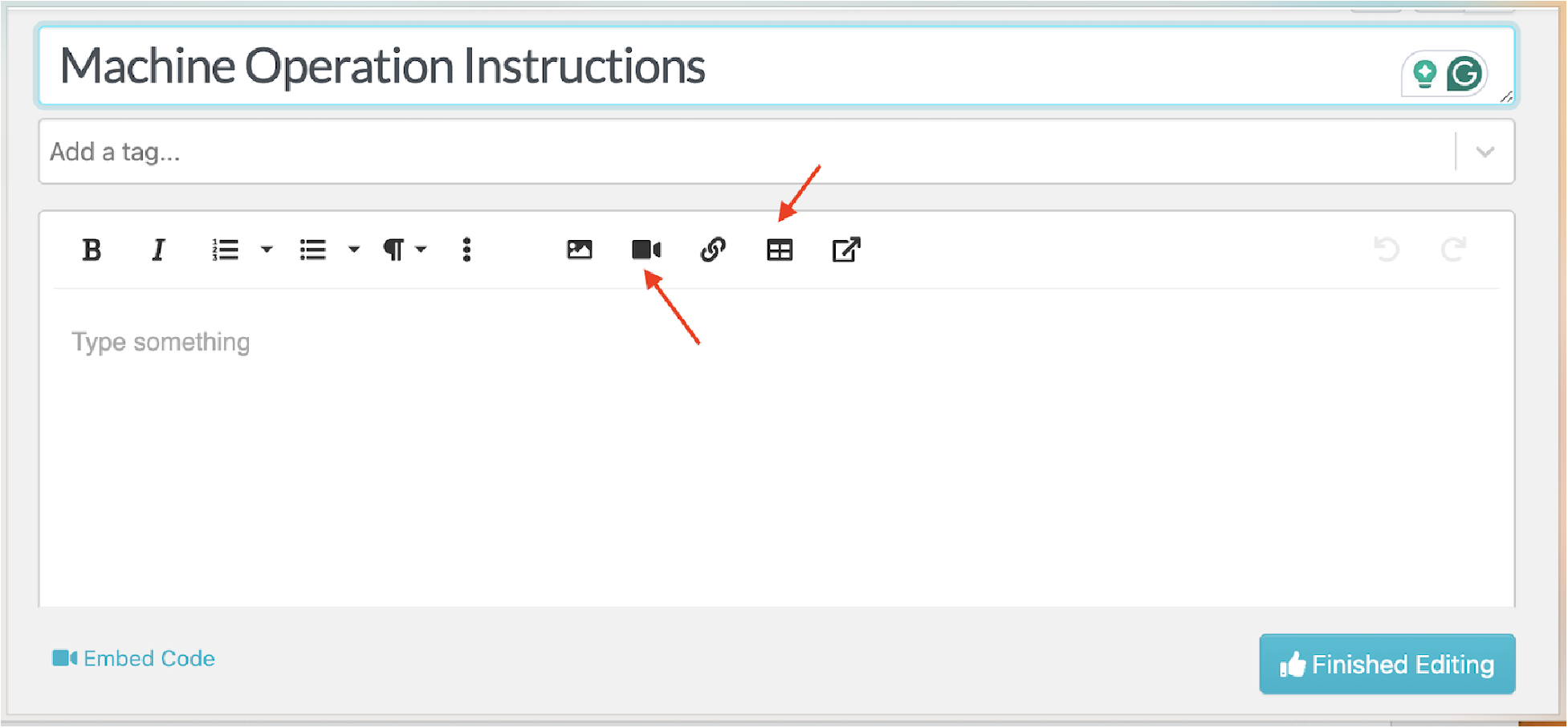
Unlike traditional documentation methods, standard operating procedure software like SweetProcess ensures that every procedure is accessible, consistent, and up to date. Therefore, you don’t have outdated files circulating among employees.
Generate and Edit SOPs Automatically With AI
Creating a manufacturing SOP manually takes hours of research, structuring, and writing. SweetProcess leverages AI to speed up the process, allowing businesses to generate SOPs automatically and then fine-tune them as needed.
Once you give your SOP a title, you can use SweetAI to generate the document in seconds.

Here’s how AI-powered SOP creation benefits your team:
- Generate SOPs instantly based on best practices and industry standards
- Quickly edit, refine, and customize procedures to fit your unique operations
- Reduce human error and inconsistencies by letting AI structure your SOP efficiently
Assign Procedures as Tasks to Team Members
An SOP is only effective if employees follow it. In manufacturing, ensuring consistent execution across teams, shifts, and locations is a major challenge.
With SweetProcess, you can assign SOPs as tasks to employees, ensuring that every worker knows exactly what to do and when. You can select the specific team members and add details such as the task name and due date.
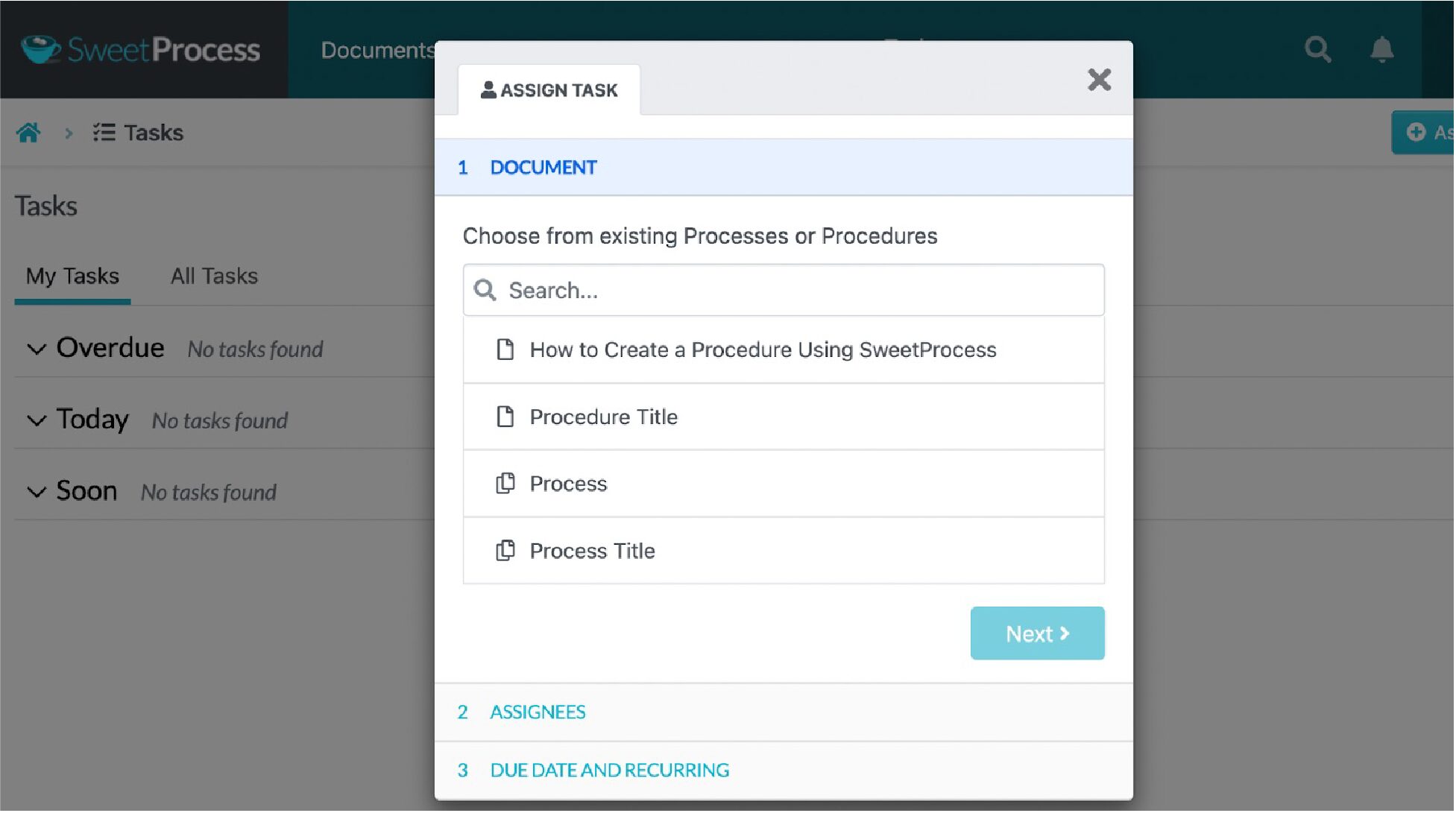
Supervisors can track progress and completion in real time by opening the “Tasks” menu.

Finally, employees receive automatic reminders to follow procedures correctly.
For instance, when a production manager assigns an SOP to a team member, the employees can work on it and update the progress without leaving the platform.
Manage Your Company’s Manufacturing SOPs in One Place
How are your SOPs stored? Are they in shared drives or printouts on the factory floor? This approach is inefficient because some of the employees may not access the updated information.
SweetProcess solves this by providing a centralized hub where all SOPs are:
- Stored in one easily accessible location. No more searching through emails or folders
- Updated in real time so that teams always have the latest version
- Accessible from anywhere since the platform is cloud-based
- Searchable and categorized by department, task, or other filters

Several companies have used SweetProcess to improve their SOP documentation process.
One of them is Marc Nelson Oil Products. The company faced a critical challenge since valuable knowledge was walking out the door whenever long-term employees left. With over 55 employees and multiple fuel stations, the company relied on skilled workers who had years of experience but lacked a structured system for process documentation.
This led to inconsistencies, knowledge gaps, and communication issues, making it difficult for new hires to settle in and perform efficiently. Determined to solve this problem, company president Peter Nelson sought expert help from a business process consultant, who recommended SweetProcess.
Peter quickly realized that SweetProcess provided a flexible, easy-to-update solution that eliminated formatting concerns while making SOP documentation seamless. Since the switch, the company now has:
- Effective process documentation: The company eliminated knowledge gaps since all the processes were documented and accessible.
- Improved employee onboarding: New hires could now access training and onboarding information in a centralized system.
- Consistent operations: Since employees could access standardized procedures in the workplace, they eliminated discrepancies in shifts.
Another beneficiary is Optiable, a document management software company. The company faced major inefficiencies due to the lack of structured business processes. The CEO, Craig Bayer, struggled with micromanaging employees, verifying completed tasks multiple times, and navigating scattered process documentation in Excel Sheets, Google Docs, and Word files.
The constant uncertainty about whether tasks were completed correctly made scaling the business impossible. Frustrated, Craig confided in a friend who introduced him to SweetProcess. After researching the tool, he was instantly convinced it was the solution he had been searching for.
Here’s how SweetProcess has transformed Optiable’s performance:
- Comprehensive SOP documentation: Craig can now record, organize, and store business processes in a structured format, eliminating the confusion of scattered documents.
- Organized workflow & increased productivity: Employees have a clear roadmap of tasks, reducing stress and allowing the company to handle more work without chaos.
- Enhanced employee efficiency: With well-documented procedures, even a virtual assistant on a different schedule can execute tasks without constant oversight.
- Automated recurring tasks: SweetProcess puts routine tasks on autopilot, ensuring that nothing slips through the cracks.
9 Manufacturing SOP Templates & Examples To Inspire Your Team

You don’t have to draft every SOP for your manufacturing facility from scratch. With templates, you can create these documents much faster, especially when managing multiple departments, processes, and compliance requirements.
We’ve compiled nine essential manufacturing SOP templates using SweetAI – our intuitive SOP generator that covers critical areas of your company:
1) Production Line SOP Template
Your production line involves several activities, such as assembling, processing, and packaging. For all these procedures to be effective, you need to outline steps for your team to follow. The production line SOP template provides a standardized approach to help you reduce inconsistencies.
Once you have this template, you can define the roles for all your team members and outline the operating times and production sequences your team should follow. It’s an essential tool if your company deals in mass production.
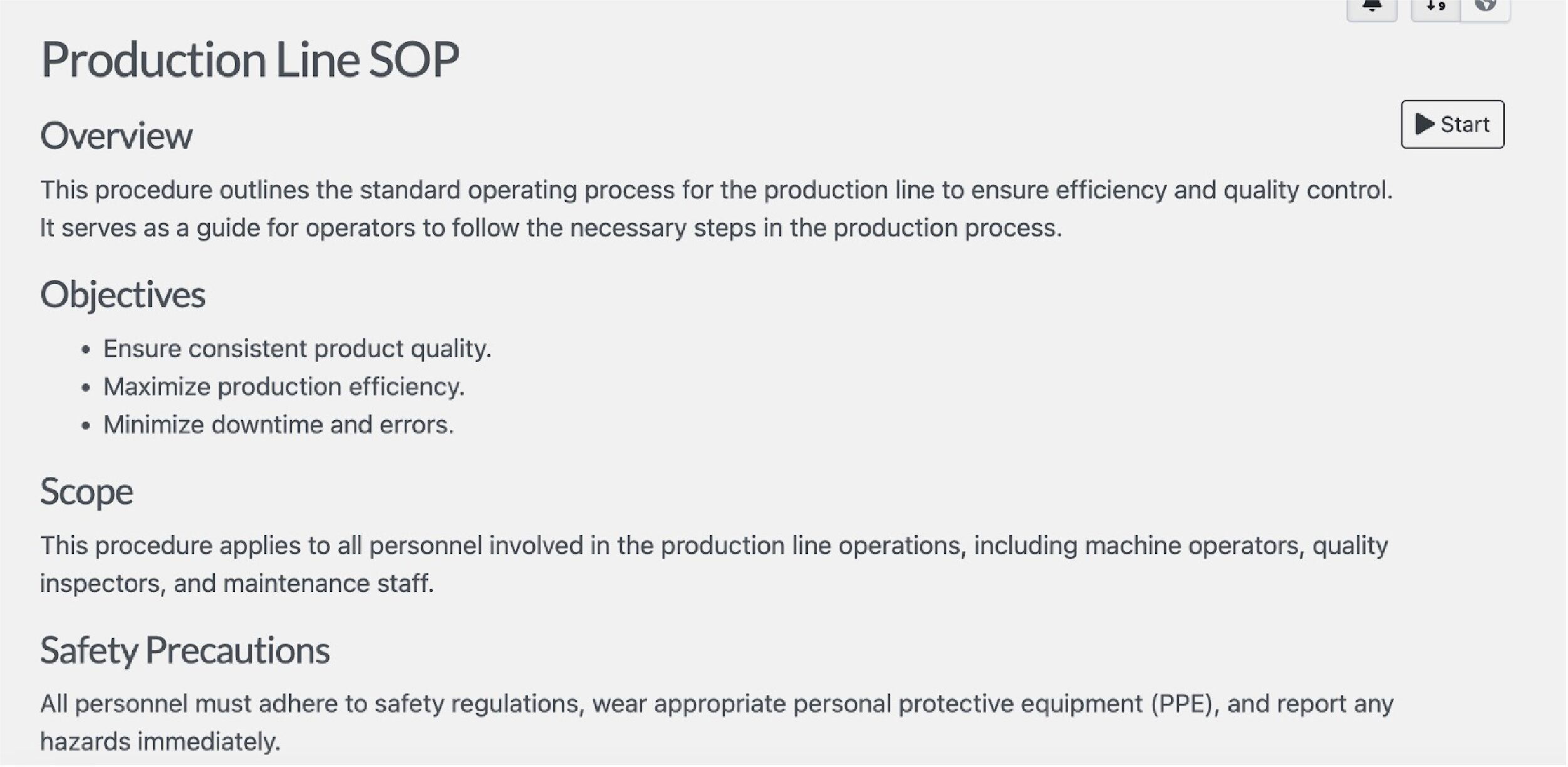
Download the Production Line SOP Template
2) Quality Control SOP Template
Quality control is non-negotiable in manufacturing. You can use the quality control SOP template to inspect, verify, and test your products at every production stage. This way, defective products don’t make it to the market. You need to use this template as part of your quality management process.
The advantages of using this template are that you establish testing procedures for all your products and corrective actions in case there are any issues.
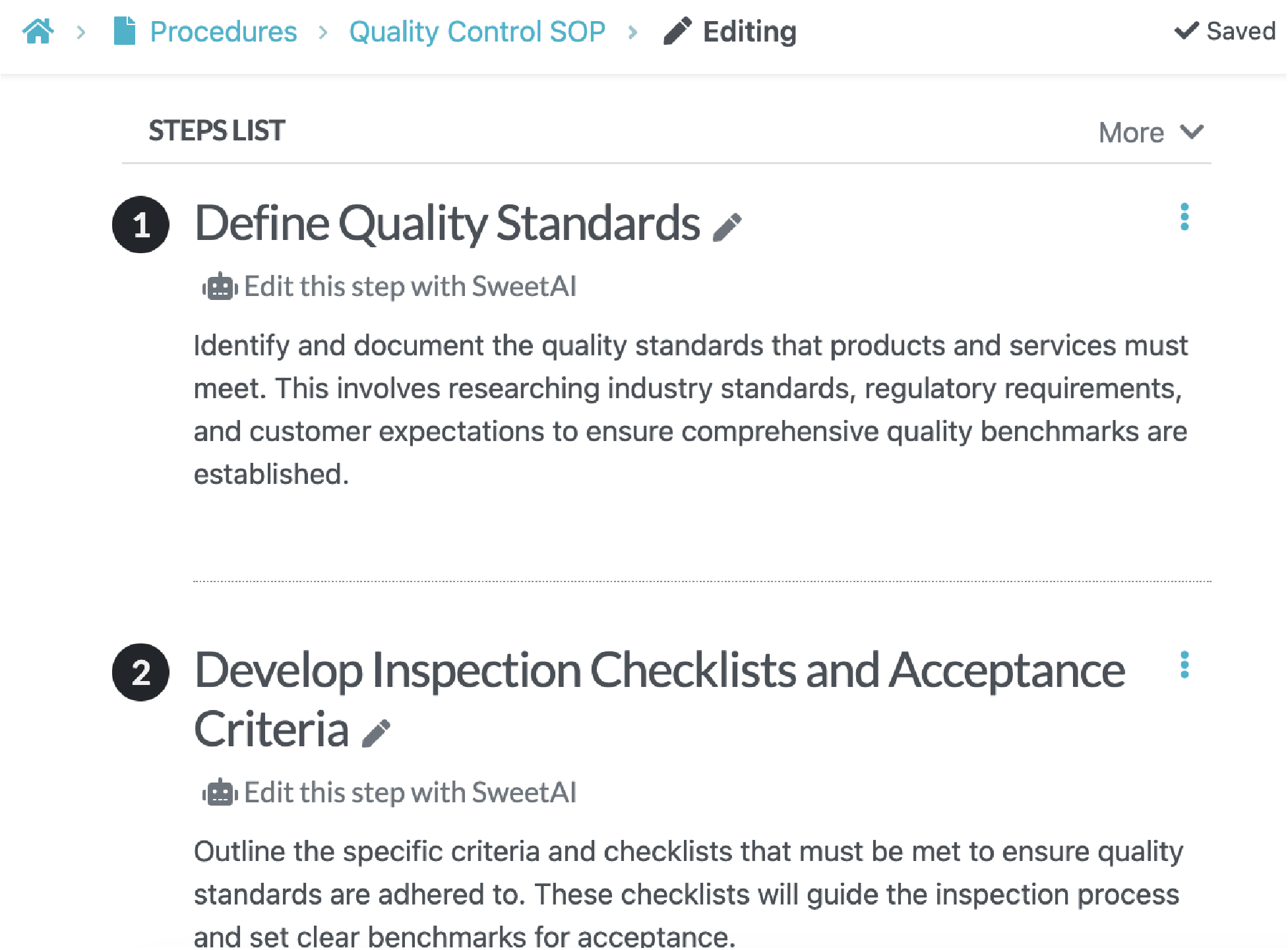
Download the Quality Control SOP Template
3) Machine Operation SOP Template
Incorrect machine operation can lead to breakdowns, safety hazards, and costly repairs. To avoid these, create a machine operation SOP template with step-by-step guidelines for operating manufacturing equipment safely.
This template can cover key topics such as equipment startup, shutdown and troubleshooting procedures, emergency stop protocols, and safety gear recommendations. It can also be used to train machine operators and reduce unplanned downtime in your facility.
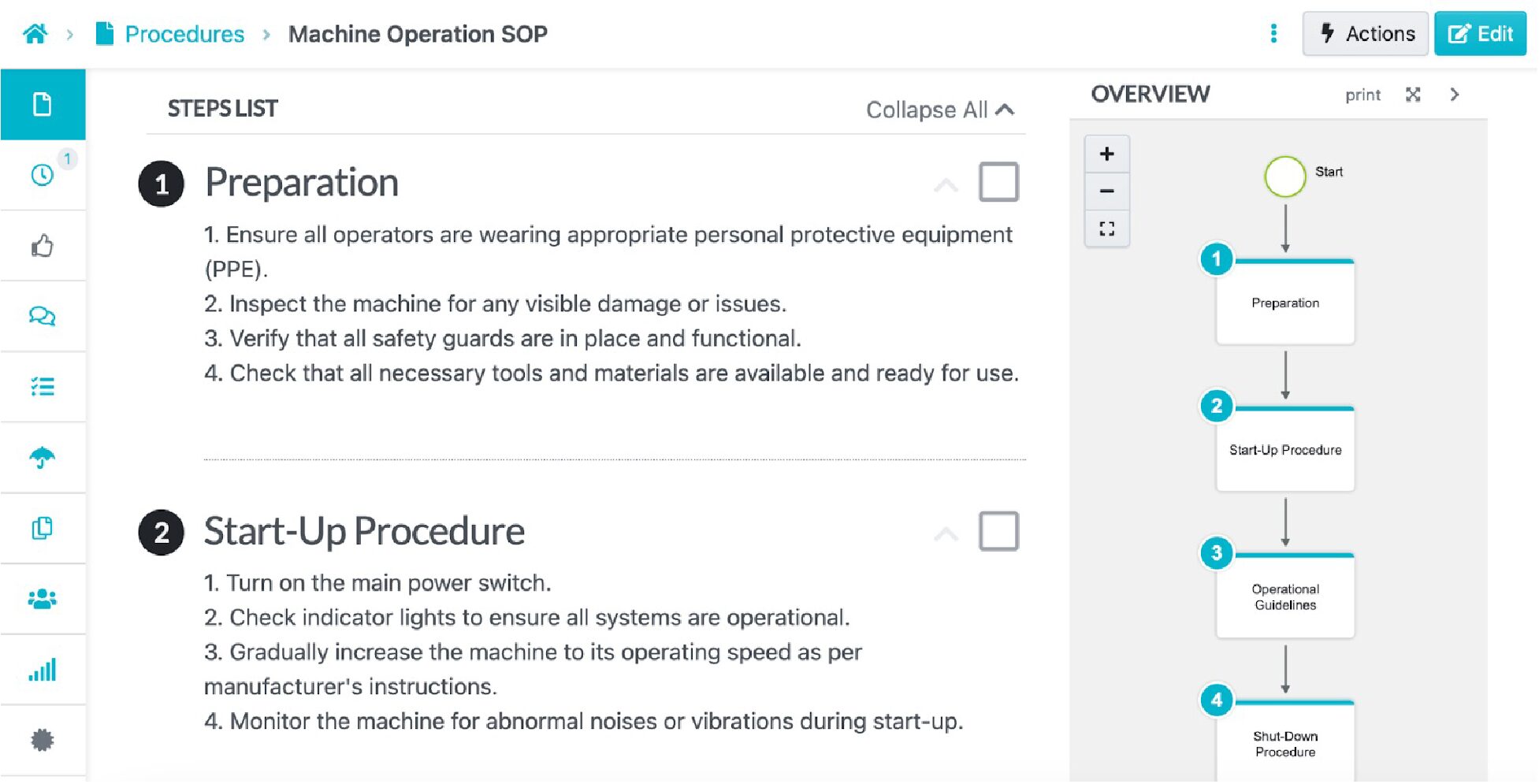
Download the Machine Operation SOP Template
4) Raw Material Handling SOP Template
If you want to reduce waste and maintain product quality in your organization, you need to handle raw materials properly. Your template will define storage conditions to reduce contamination risks in your production process.
You can also use this template to outline inventory tracking procedures and include safety handling instructions for hazardous materials.

Download the Raw Material Handling SOP Template
5) Warehouse & Inventory SOP Template
A well-organized warehouse ensures that materials, tools, and finished products are easily accessible and properly accounted for. This SOP template can be used to standardize inventory management, stock movement, and warehouse safety.
Some key elements to include in the warehouse and inventory SOP template are receiving and stocking procedures, lot tracking, inventory reconciliation, warehouse organization, space optimization, and handling rules. This will improve inventory accuracy and reduce stock shortages.

Download the Warehouse & Inventory SOP Template
6) GMP Compliance SOP Template
Good Manufacturing Practices (GMPs) ensure that products are consistently produced and controlled according to quality standards. This GMP compliance SOP template helps your team stay compliant with industry regulations.
For instance, you can outline hygiene and sanitation procedures and standardize employee training and record-keeping requirements. Once this is in place, it becomes much easier to pass regulatory audits and maintain high-quality production standards.
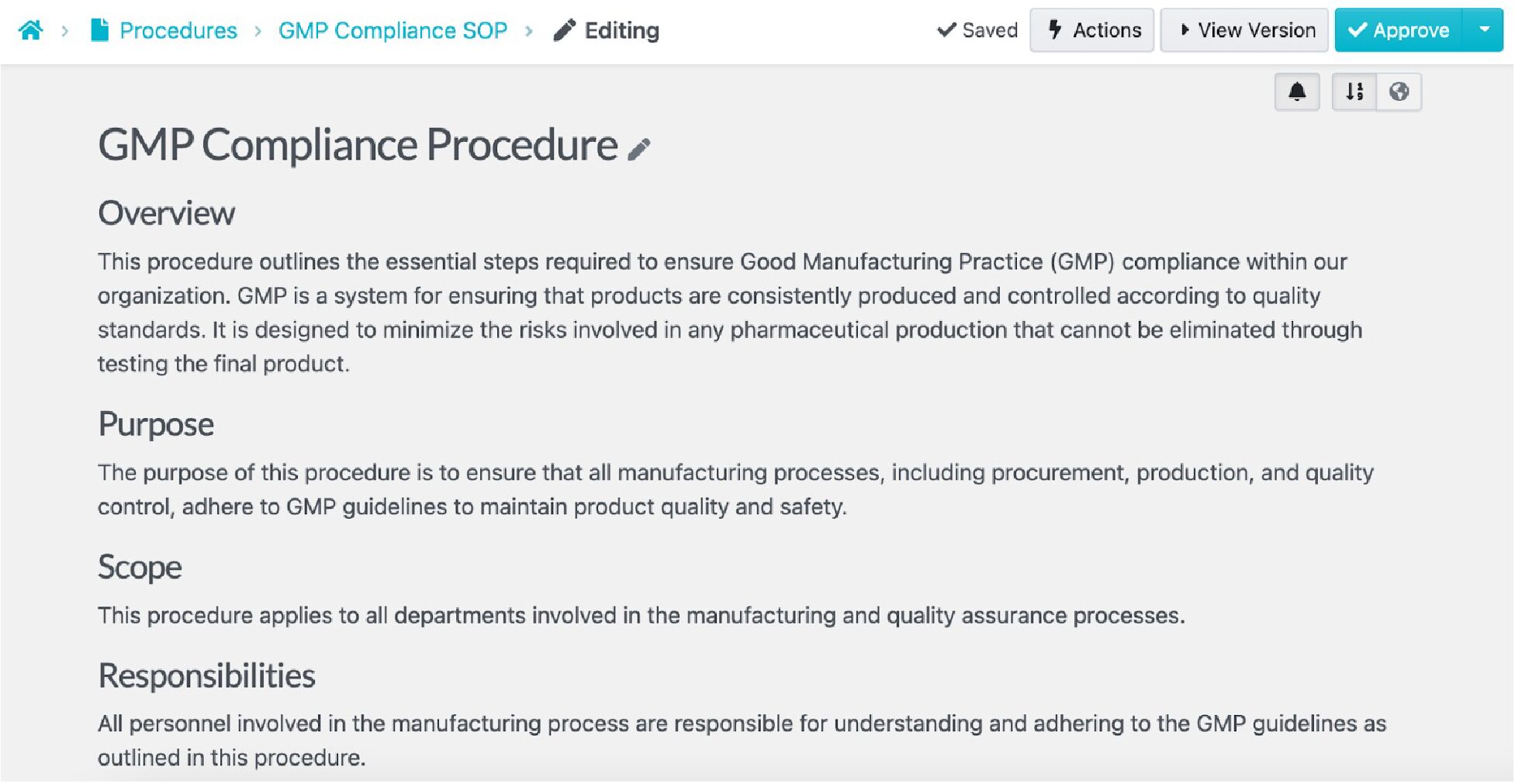
Download the GMP Compliance SOP Template
7) Factory Maintenance SOP Template
Regular maintenance prevents costly machinery failures and ensures smooth operations. This SOP template helps maintenance teams conduct routine inspections, preventive maintenance, and repairs efficiently.
You can include details about scheduling routine maintenance tasks, safety checks, repair workflows, and measures to minimize downtime by implementing proactive maintenance strategies. With this document, you can reduce equipment malfunctions and repair costs while extending machinery lifespan.

Download the Factory Maintenance SOP Template
8) Safety & Hazard Control SOP Template
Manufacturing environments pose serious safety risks if proper procedures aren’t followed. You need to outline key elements such as personal protective equipment usage, emergency response plans, and other workplace safety standards to avoid issues.
This safety and hazard SOP template provides clear safety protocols for preventing workplace accidents and handling emergencies.
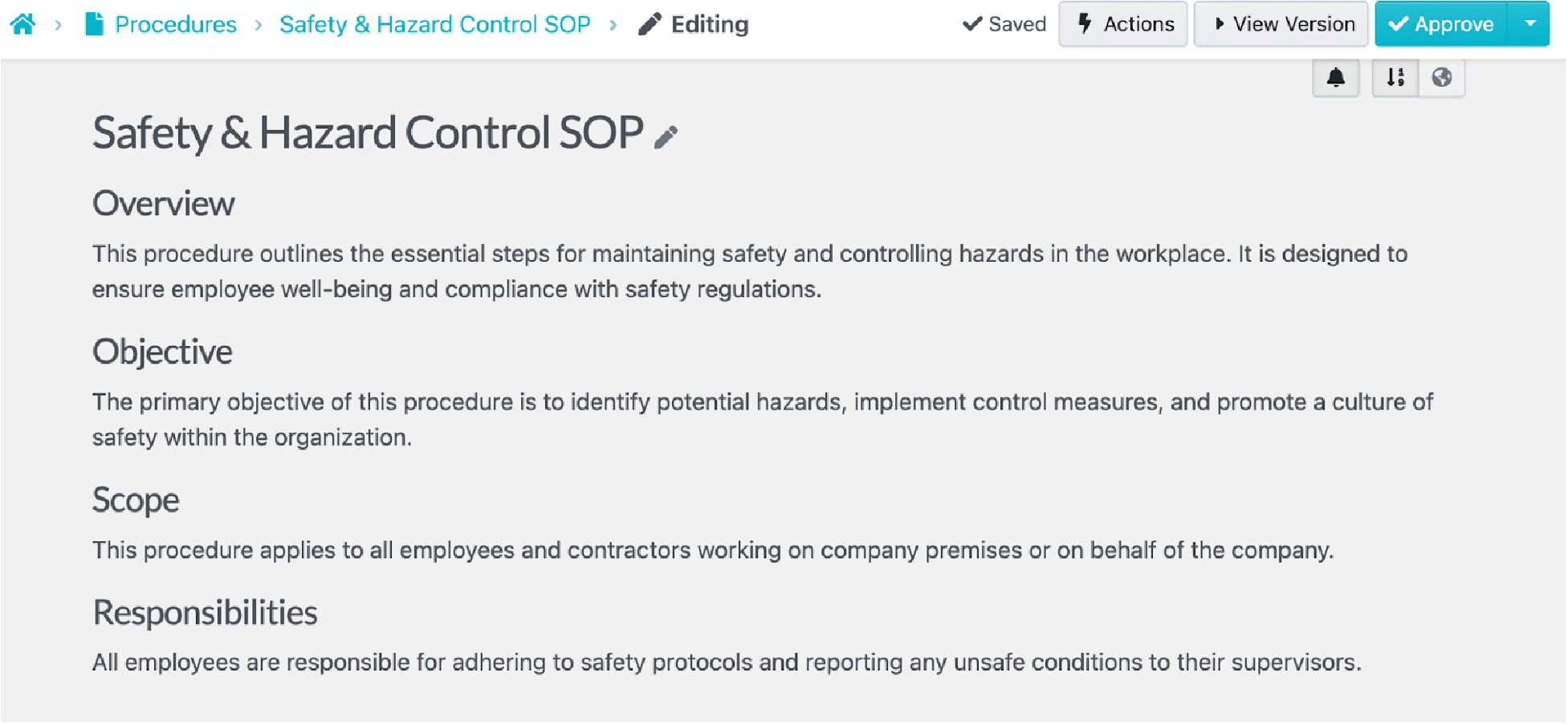
Download the Safety & Hazard Control SOP Template
9) Packaging and Labeling SOP Template
Your products need the correct packaging and labeling; otherwise, you might lose customers due to quality issues. With a packaging and labeling SOP template, you can establish the packaging steps your team should follow to meet quality standards and regulatory requirements.
You can outline key standards, including the packaging materials to use, barcode placement, and quality control checks to prevent packaging errors.

Download the Packaging & Labeling SOP Template
Real-Time SOP Examples Used by Manufacturers

Want to implement SOPs in your manufacturing facilities? Here are some examples of companies that have done the same.
Cisco: Flow of Materials in the Manufacturing Unit
This SOP outlines the procedures for handling materials within a manufacturing unit, with a focus on quality control and safety. The key procedures include the visual inspection of 3D-printed parts for contaminants or defects, and mechanical flexing tests to ensure parts don’t break under stress.

Haryana Labour Department: SOP for Safe Operations on Hazardous Manufacturing Processes
This document provides SOPs for various hazardous manufacturing processes, including the manufacture of aerated water.
Each section details specific safety measures, equipment requirements, and procedural steps to mitigate risks associated with hazardous materials and processes.

US Environmental Protection Agency
The US Environmental Protection Agency (EPA) created SOPs to assist organizations in documenting routine procedures within a quality system. This document emphasizes the importance of SOPs in ensuring consistency, quality, and compliance across various operations.
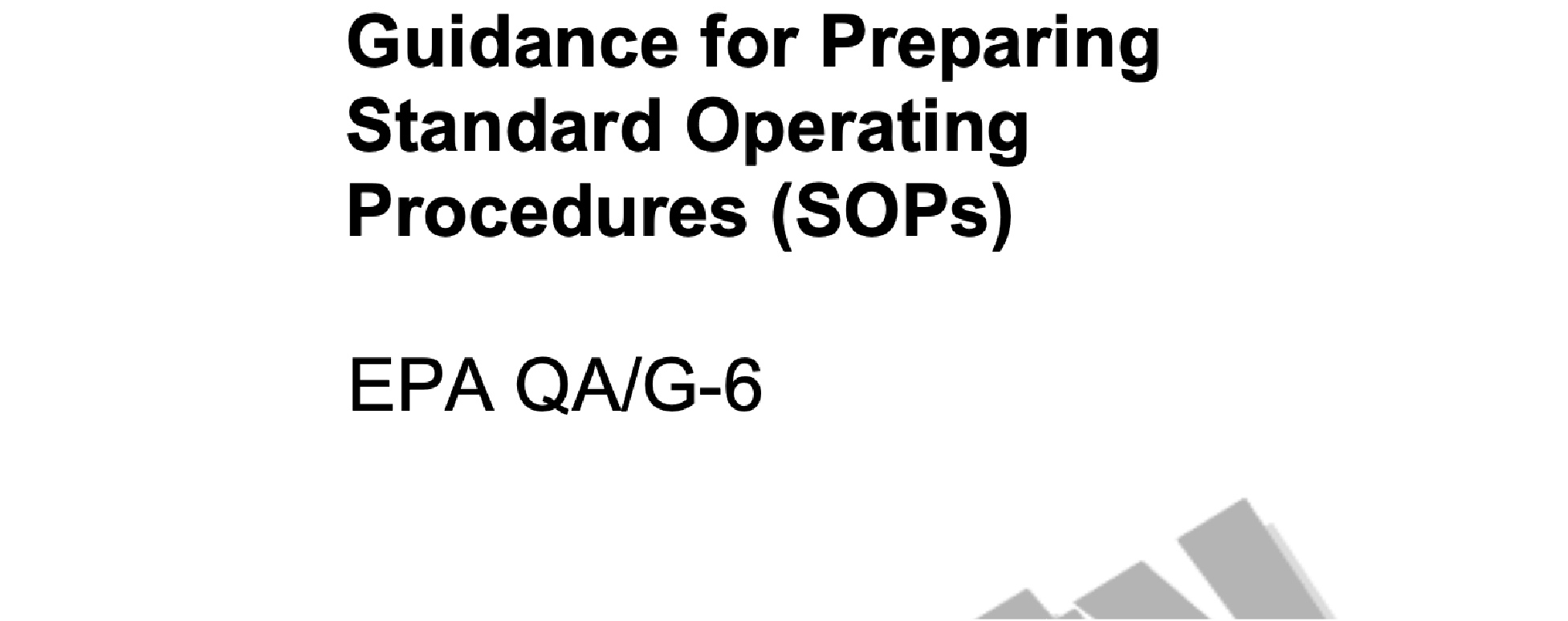
Digitalization of Manufacturing SOPs: Reasons and Benefits

Manufacturing SOPs are no longer stored in bulky paper binders. As technology evolves, manufacturers are embracing digital SOPs to boost collaboration efforts among team members. This switch to digital SOPs is essential for this industry that demands consistency.
Let’s look at the reasons why manufacturers are shifting to digital solutions and how this has benefitted their companies.
Easy Access and Collaboration on Work Instructions
If you operate in a large-scale operation with multiple facilities, it’s more challenging to manage paper-based SOPs. You have to print out the latest SOPs and distribute them to teams. These documents may not reach every employee, or they may become outdated.
Your procedures need to be accessible from anywhere, and that’s where digital SOPs come in. Storing your SOPs in a cloud-based tool ensures that every operator, supervisor, and quality control team member has access. This way, they can add comments and update the latest instructions, and everyone can view this in real time.
Continuous Improvement
Manufacturing processes evolve constantly due to new technology or regulatory changes. Updating paper SOPs is a logistical nightmare, often requiring manual edits, reprints, and redistribution. On the other hand, digital SOPs allow for seamless updates and continuous improvement without too much disruption.
Once you digitize your manufacturing SOPs, you can get:
- Instant updates to ensure that employees always follow the most current procedures
- Data tracking and analytics to provide insights into which SOPs need refinement based on employee feedback or performance metrics
- Automated notifications to inform teams when changes are made, keeping everyone aligned with new protocols
Reduced Training Cost and Time
Training new employees in a manufacturing setting can be expensive and time-consuming, especially when relying on outdated printed manuals. However, digital SOPs can accelerate onboarding and upskilling, enabling workers to learn at their own pace with interactive guides and real-time support.
On-demand access to training materials allows employees to review SOPs anytime, reducing the need for repetitive in-person training. Additionally, you can add step-by-step digital walkthroughs, video demonstrations, and interactive simulations to enhance understanding and retention.
Preservation of Organizational Knowledge
When experienced employees leave or retire, they often take years of valuable process knowledge with them, creating gaps in manufacturing workflows. Digital SOPs act as a centralized knowledge repository, ensuring that critical procedures are preserved for future generations of workers.
Here are some of the advantages of these SOPs:
- The standardized documentation prevents reliance on tribal knowledge and undocumented “insider” methods.
- Knowledge-sharing platforms allow seasoned employees to contribute insights, ensuring that best practices are retained.
- Version history and audit trails capture process improvements over time, making it easier for new hires to understand past decisions.
Streamlined Tracking and Version Control
One of the biggest challenges with paper-based SOPs is version control. Multiple copies of outdated procedures can circulate among employees, leading to confusion and errors. Digital SOPs solve this problem by offering automated version tracking and real-time audit logs.
The version control features ensure that employees always access the latest approved SOP. Moreover, you can implement automated compliance tracking, which helps you stay aligned with industry regulations.
Create and Manage Your Manufacturing SOPs in One Place

Imagine walking into your manufacturing facility and knowing every machine is running smoothly, every employee is following the same high standards, and every process is optimized. No more production delays, no more costly errors, or scrambling to update outdated paper SOPs. That’s the power of well-documented, digital SOPs—and it’s exactly what SweetProcess delivers.
Effective manufacturing SOPs ensure tasks are performed correctly every time. However, manually creating, managing, and updating SOPs is a tedious nightmare. Paper-based procedures get lost, employees struggle with outdated instructions, and revisions become a logistical mess.
With SweetProcess, manufacturing companies can:
- Create SOPs effortlessly: No formatting headaches, just structured, easy-to-follow procedures.
- Keep all SOPs in one place: They will be accessible anytime, anywhere, on any device.
- Ensure compliance and consistency: SweetProcess has built-in version control and approval workflows.
- Train employees faster: The SOPs include videos, images, and step-by-step guides.
- Collaborate in real time: Teams can update, refine, and optimize processes without confusion.
